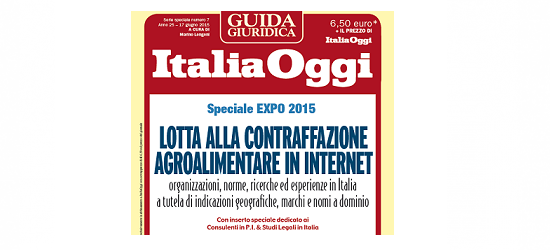
Simona Cazzaniga, Massimo Perocco and Matteo Maggio
Counsels of Studio Legale Sutti, Milan
According to the Italian Ministry of Economic Development, the “Italian Sounding” is a complex phenomenon encompassing all foreign products that recall Italy, while they actually do not come from Italy. It includes mainly imitative products which display a mix of Italian names, logos, images, slogans, colours, all clearly and unequivocally related to Italy: cheeses resemblant Parmesan but made in the United States, cheeses sold with the trademark “Parmesao” in Brazil and “Regianito” in Argentina; wines resemblant the Italian ones called “Barollo” and “Cantia”, tomato sauce “San Marzano“ made in California or pasta “Milaneza” that none affiliation could even claim with Milan…
The Italian Sounding attempts to create an artificial link between the product itself and Italy and it works not only through texts and words associations, but also through a visual communication. The latter combines both in advertising and packaging image, information and elements leading to Italy (e.g. the colours of the Italian flag used in the packaging or the combination of the images of basil-mozzarella-tomato in local products visually reproducing the Italian tricolour flag), while the texts and words affect the trademark and claim in order to give an ambivalent yet exotic Italian taste to the name of the product (for example, the “Nespresso” brand clearly suggests the Italian word “espresso” and the related Italian way of enjoy coffee and… life).
The afore mentioned phenomenon plays strategically a role for Italian exportation, having a negative impact on it; indeed, the latest authorities’ more detailed assessments put the estimate of direct damage caused by the Italian Sounding to Italian SME around 54 billion of Euro, which is about two times the total turnover of exports of Italian original products[1]!
The numbers and figures alone show the paradox of our food system – or rather of our food policy – which appears two-faced; While in our domestic market we apply strict regulations as consumer protection – like the Italian “Made In” mandatory rules – forcing Italian companies to comply with cumbersome Italian requirements and related high costs, in the overseas market, on the contrary, we still fail to give companies an adequate protection, frustrating the possibility for them to exploit the (real) Italian traits of their products, not providing the tools for fair competition.
For example, if it is true that the Italian laws on unfair competition, collective marks, geographical indications and designations of origin provide the companies with sufficient tools in order to defend themselves in our jurisdiction, the same does not apply when the damage occurs outside the national borders, as the Italian Sounding proves.
Finally, given the deficiencies and/or lack of protection in current foreign regulations, it appears feasible as ways to counter the Italian Sounding:
1) Better promotion of Italian products abroad
In this respect, it is useful to recall that the UIBM has developed a project for the promotion and enhancement of Italian food products, implemented in 2011 in Canada and in 2013 in Russia. Furthermore, in the Commission of Industry, Commerce and Tourism in Parliament is still under consideration the drafted Italian Legislative Decree no. 1061, dated 09/26/2013 on the establishment of an official trademark “Italian Quality” which should allow the recognition of original Italian products abroad.
2) Execution of special agreements with the countries most affected by the phenomenon
As far as possible agreements on Italian Sounding are concerned, negotiations are still pending between the US – world’s leading market for wine and pasta – and the EU, on the future Treaty on the Transatlantic Trade and Investment (the draft of which still being secreted for the time being) that would yet simplify the exchanges between the leading world markets, but would face the issues of unlike levels of protection of food products alone in EU compared to the US one.
[1] Report Iperico (database Ministero Sviluppo Economico) 2014.
